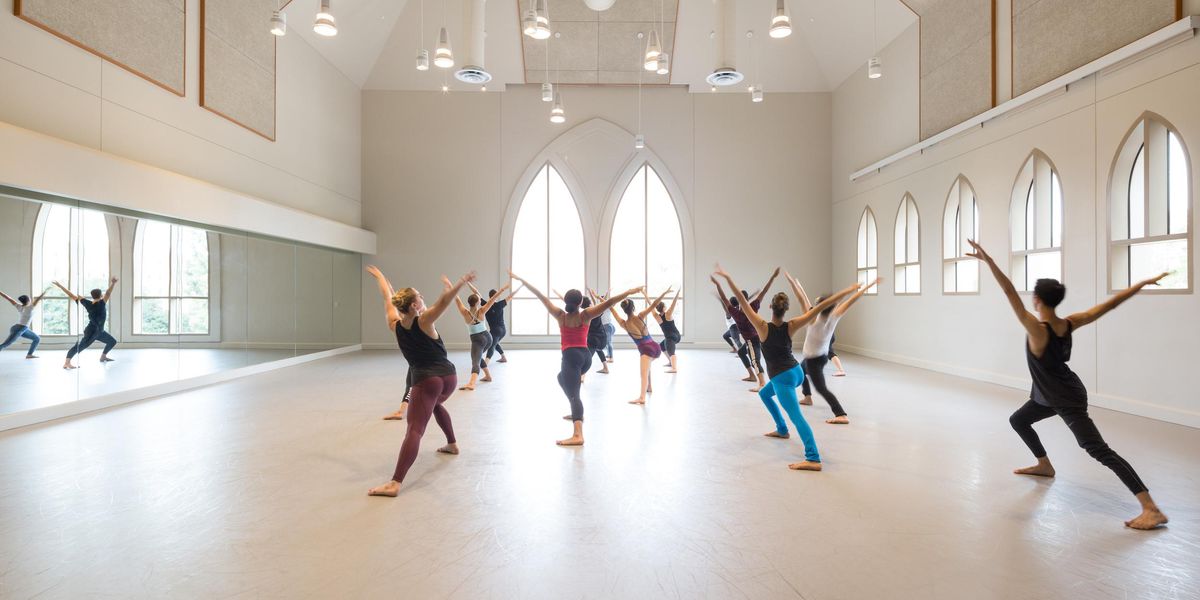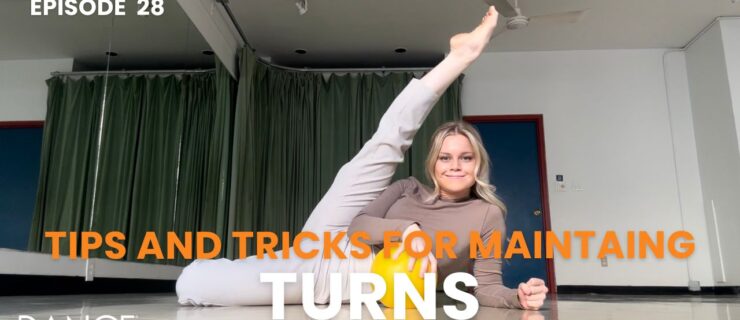2015 Summer Study Guide: A Legendary Summer
Twyla Tharp’s summer workshop offers dancers a rare opportunity.
Longtime Tharp dancer and workshop instructor Rika Okamoto demonstrates a movement. Photo by Kyle Froman.
Reed Tankersley (left) and other workshop dancers. Photo by Kyle Froman.
It’s the third week of the Twyla Tharp Summer Workshop at Barnard College in New York City, and 30 students are in a repertoire class working on Tharp’s iconic piece, The One Hundreds. They’ve already learned phrases 1 through 25, and teacher and longtime Tharp dancer Rika Okamoto is beginning to teach section 26. She starts by demonstrating the legs—a series of rocking motions, popped arches and relevés. The students—who include high school and college dancers, as well as professionals—pick it up quickly. They also easily grasp the head’s movements, and then the eyes, when taught individually. But when Okamoto asks the dancers to put all the elements together, things fall apart. They clearly struggle, laughing nervously as they try to coordinate the conflicting motions. “This one’s almost impossible,” Okamoto says to the class. “I know maybe one person who’s ever been able to do it correctly.”
Participants in a class. Photo by Kyle Froman.
It’s clear that the perfect candidates for this workshop are those who are interested in truly being challenged. “The movement is difficult, but I think it’s one of the reasons that people are in the room,” says Tharp. “They want to be challenged physically and mentally. It’s important to me when I audition dancers that they can think quickly and that they’re not intimidated by new information. That’s one of the things we really focus on giving these students.”
Indeed, interesting movement is only half of what makes Tharp’s choreography so special. It’s also the intricate, often mathematical, patterns—plus, the opportunity for dancers to make their own choreographic choices. “Twyla told us that dancers have to be wildly independent,” says workshop attendee Austin Sora, a recent graduate of Marymount Manhattan College and apprentice with Buglisi Dance Theatre. “It’s important to be a thinking dancer and not just expect an authority figure to tell you what to do. I’ll take that lesson with me.” This autonomy is clear later in the day when the dancers work on Tharp’s The Fugue; dancers are told to decide in the moment when they will incorporate different bits of choreography, and are expected to count at their own pace, instead of listening to music.
Austin Sora works through a phrase. Photo by Kyle Froman.
The workshop will be given again this summer for two weeks in New York City. Each day starts with a technique class, with every phrase specially designed by Tharp to introduce students to her style. “My approach to teaching is a one-room school house; there’s something for everyone,” says Tharp, who calls the first technique class of the day Treefrog. It includes a strength-training warm-up, a series of center combinations designed to work through every muscle in the feet, legs and abdominals, and complex, high-energy across-the-floor combinations that look like they could have easily been taken straight from Tharp’s choreography. Each element is designed to keep dancers centered, on their leg and working their feet into the floor—important tools that can easily be translated into any style students focus on in the future. “Treefrog is about the paradox of being very grounded yet very high on the leg,” Tharp says. “It’s intended to make the dancer capable of moving in any direction very quickly, like a boxer.”
After morning technique class, the students have an hour and a half of Tharp repertoire. After lunch, they have another 45-minute technique class to warm up, followed by two and a half more hours of repertoire. The dancers learn excerpts from a selection of Tharp’s works, which are performed at an in-studio showcase. Like the technique classes, the repertoire is chosen specifically for its range, both in technical difficulty and style. The Fugue tests dancers’ memory, The One Hundreds works on counterpoint, Sweet Fields is classically based, Surfer At The River Styx is grounded in modern technique and Ocean’s Motion has a rock-and-roll edge.
As varied as Tharp’s choreography is, so are the dancers who are attracted to her program. “We have some classically trained dancers in the workshop, some who are more focused on modern dance and some with very little training, who are here to move and to think,” Tharp says. “I’m interested in everybody.”
While most dancers in attendance have experienced either Tharp choreography or technique in some context (Sora, for example, had taken Treefrog class at Marymount), they are generally not fluent in it. “A lot of these dancers have seen Twyla’s ballets,” Okamoto says. “But they’ve never seen what goes behind them.” So the program starts with the basic concepts of her movement, but progresses quickly.
Participants in a class. Photo by Kyle Froman.
“Your brain almost explodes by the end of each day,” says attendee and recent Juilliard graduate Reed Tankersley. “When we’re taught information, we’re expected to retain it the whole time, which has kept me on my toes.”
While Okamoto and 14-year Tharp dancer Alexander Brady generally lead classes and repertoire sessions, during the 2014 workshop, Tharp was often in the building, drifting in and out of the studio and stepping in to give the occasional correction or note. And from time to time, she taught the entire afternoon technique class—a rare occurrence for Tharp, who seldom even accompanies Okamoto or Brady when they set works on professional companies.
The prevalence of Tharp’s choreography makes knowing her style a valuable weapon for any aspiring professional. Indeed, there are few genres in which dancers won’t encounter Tharp’s work. And now, as The Joyce Theater’s current artist in residence, she continues to create work, and the Tharp ballet masters and dancers offer daily open company class at the Dance Art New York Studios. “She does concert dance, she does Broadway, she does ballet,” says Tankersley, who started dancing for Tharp after the workshop. “What I’ve learned here will be useful no matter where my career takes me.”
Rachel Zar is a freelance writer in Chicago.




